STEM Books: What (We Think) Works
Posted by Yamini Vijayan on May 11, 2017Since its inception, Pratham Books has published a range of picture books that explore STEM (Science, Technology, Engineering and Math) topics in interesting ways. But it is since 2015 that we have been doing this in a much more focussed manner. The main reason for this was the realization that there aren’t enough multilingual information books available for early readers in India. The fact that many children find science and math slightly daunting made this even more of an interesting challenge because we felt that we could help change this perception by creating fun, memorable books around STEM topics.
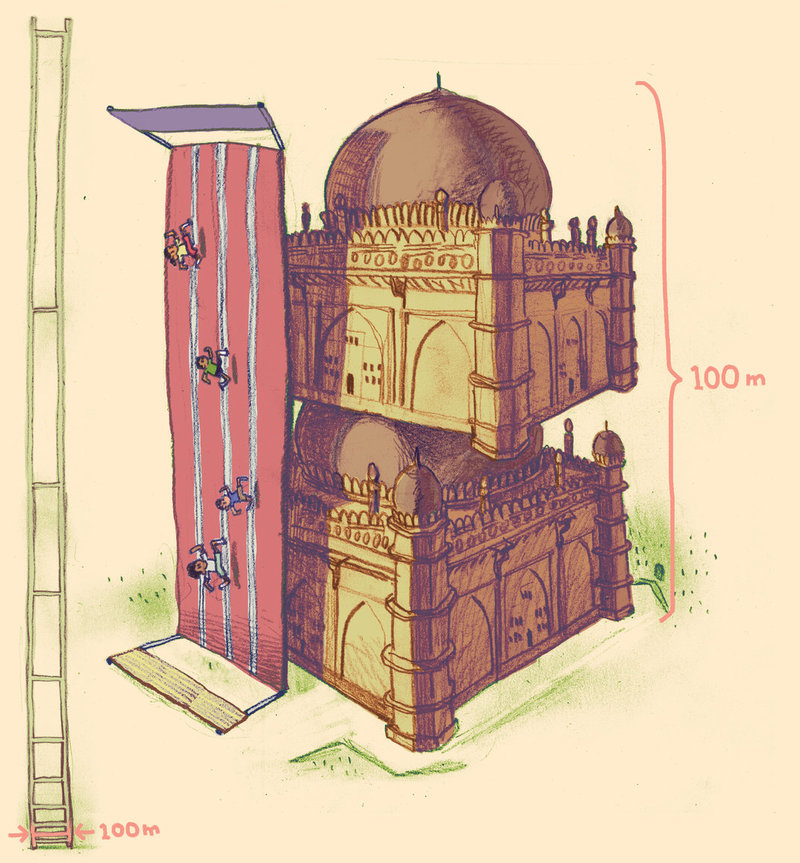
While we've been exploring a number of ways to introduce STEM topics to children, one of the biggest challenges has been to present information accurately, imaginatively and in a simple way without making it seem 'textbookish'. So it was essential that we paid attention to the narrative, plot and tone of each book so that children are drawn to it.
Since we work extensively with children from economically disadvantaged backgrounds, it is important that our books are relevant to these children. Conversations with partner organizations who work closely with these children reveal the need for simpler books as their reading fluencies are still developing. Bearing that in mind, our focus has been on creating simple books that encourage children to explore the world around them with an open mind, ask as many questions as they possibly can and find ways to apply their knowledge.
We continue to be keen to create STEM books, so we thought it might be interesting to highlight a few books that were created over the last couple of years, mainly as a way for us to reflect and share our learnings. So what worked?
Clarity of concept – An important aspect of a STEM book is its ability to demonstrate the concept clearly. I Spy! (by Samvida Venkatesh & Sandhya Prabhat) explains the concept of subtraction wonderfully - using play and humour.
Simplicity – Most of our conversations with our outreach partners lead us to the same conclusion: the need for simpler books that match the reading levels of the children we work with. Sunando Chakraborty’s Sniffles, a story about how flu spreads, is an excellent example of this. Also, we adore the central character of this book. Satya, Watch Out! is another good example of simplicity of narrative and plot.
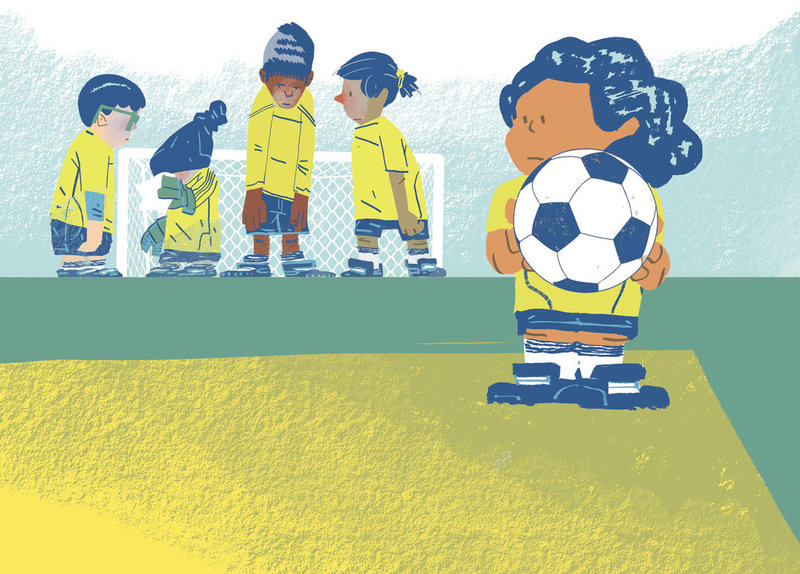
Good storytelling – Jadav and the Tree-Place won the Best Digital Book award at the Publishing Next conference last year. This story – about forester Jadav 'Payeng' Molai - stood out for us as well mainly because it is an inspiring story narrated powerfully by Vinayak Varma.
Using humour – Rajiv Eipe’s Ammachi’s Amazing Machines has been a big hit with our readers for many reasons! But one reason for its popularity is the gentle humour that runs through the story, especially in the art. While it can be challenging to include humour in STEM books (imagine having done this in a story about simple machines!), we can tell you that it works wonders.
Seamlessly blending fiction and non-fiction – It isn’t easy to strike the right balance between fiction and fact, so we were delighted to publish A Butterfly Smile (by Mathangi Subramanian & Lavanya Naidu) which has managed to achieve this. In this, a girl who is new to the city shares her knowledge of butterflies with her classmates and also learns new facts about them. At the same time, it highlights migration due to environmental and economic reasons. Another story that managed to do this successfully is Dum Dum-a-Dum Biryani! (by Gayathri Tirthapura & Kabini Amin) which explores the fascinating relationship between math and cooking.
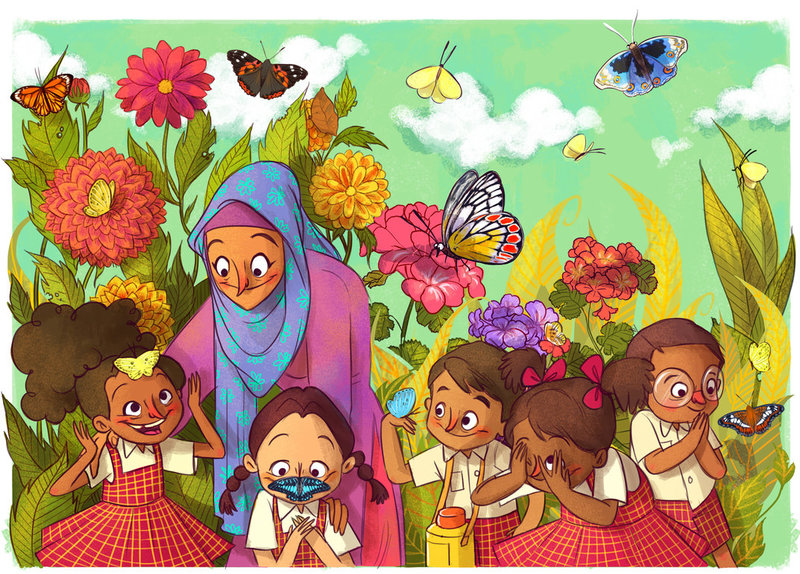
Widening the imagination – What better way to talk about this than directing you to How Far is Far? A book about distances, big numbers and measurement, Sukanya Sinha and Vishnu M Nair have created an exceptional math book which stays true to the core ideas of math: play and exploration.
Memorable characters – Being able to create characters that stick in our memory is an admirable skill. Including memorable characters naturally makes it easier for children to retain the concept and story. In that regard, some of our favourite characters are: the quirky grandmother from How Old is Muttajj? (by Roopa Pai & Kaveri Gopalakrishnan), the endearing gharial from Ghum-Ghum Gharial's Glorious Adventure (by Aparna Kapur & Roshan K), adventurous Arya from Arya in the Cockpit (by Nandita Jayaraj & Upamanyu Bhattacharyya) and the perpetually hungry Neema from Bijal Vachharajani and Priya Kuriyan's What's Neema Eating Today?.
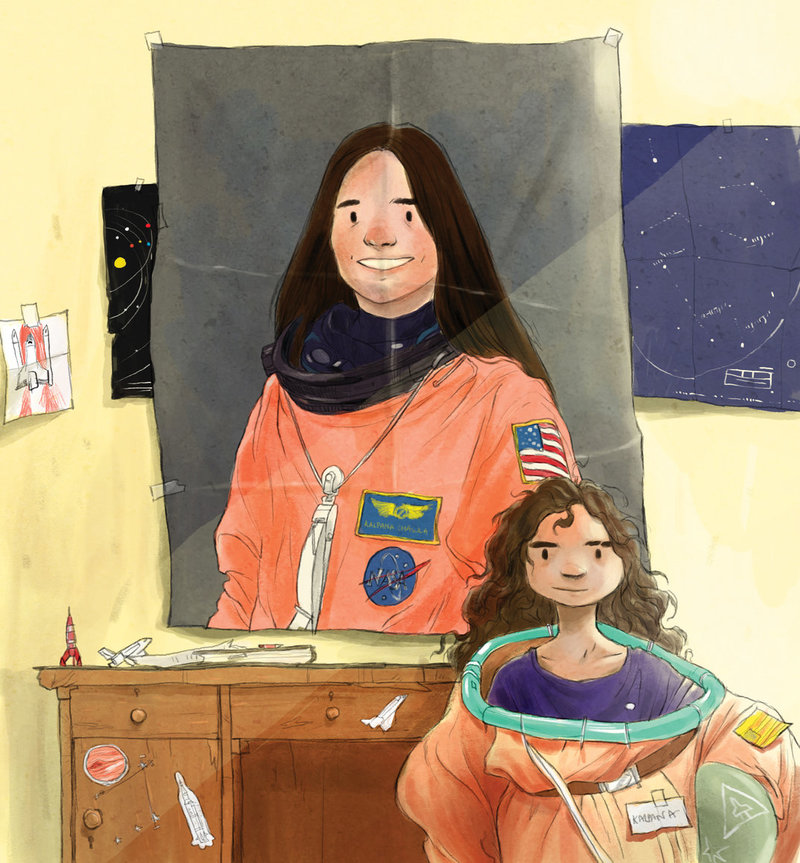
Reinforcing the concept through activities – In the case of STEM books, it’s very helpful to have fun, practical activities at the end of the book. Children seem to enjoy this as it allows them to engage with the concept in a real way and not be passive consumers of information. A Butterfly Smile has a really fun activity at the end of the story. We’ve been told by teachers that How Old is Muttajji? was well received because children enjoyed the interactive nature of the narrative which challenged them to think, much like solving a puzzle.
Pure non-fiction – Although we haven’t done much in terms of straightforward non-fiction, we are beginning to see the massive potential of this. The only reason we didn’t do much of this is for the fear of seeming ‘textbookish’. But the response to books like How Does Toothpaste Get Into the Tube? (by Veena Prasad & Rajiv Eipe) has made us realize that we should look at publishing more of these. This book has certainly done well in choosing the right question – a question that is likely to baffle us, and one that doesn’t have very obvious answers.
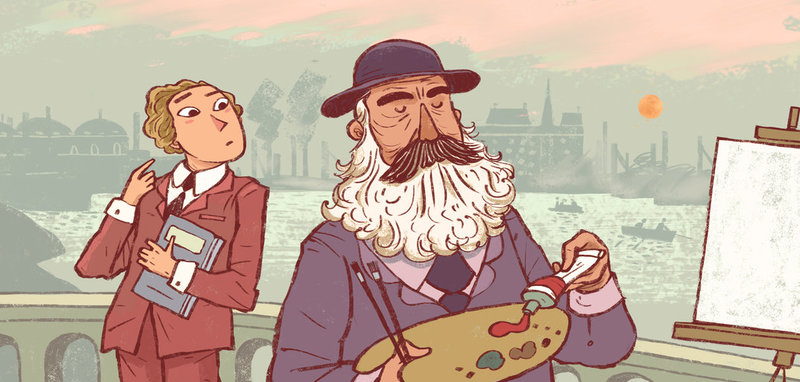
Ability to relate – Some of the stories that children have quickly taken to are the ones that they find easy to relate to. For instance, One by Two (by Maya Bisineer & Shreya Sen) which is essentially about division but involves a lot of food sharing which is familiar to most of us.
Fascinating topics – Very often, finding a theme that is of interest to children is half the battle. Of course, this is an old trick! But, it’s a useful one – especially for STEM stories. Just last year, we commissioned Gul in Space (by Richa Jha & Lavanya Karthik) and Kaakaasaurus (by Shalini Srinivasan & Prabha Mallya) because... well, space and dinosaurs!
Good for Read Aloud – We decided to include this point only because we find that a lot of our books are read aloud in schools. So it’s always wonderful to have STEM stories that are fun to read aloud. A perfect example of this is Anupama Ajinkya Apte's Gulli’s Box of Things - a STEM book we published a few years ago (in print).
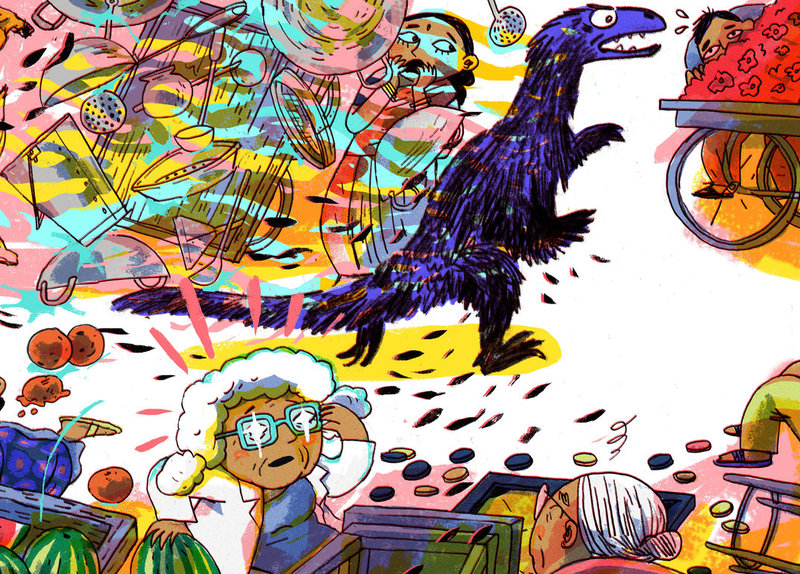
All the STEM books that are mentioned here are available for free on StoryWeaver in English, Hindi, Marathi, Kannada and Tamil.
Be the first to comment.Teachers and Tales
Posted by Remya Padmadas on May 11, 2017Our Outreach Manager, Payoshni Saraf reports back after three days of stories, storytelling and learning workshop with SCERT Delhi.
A common wisdom that all of us who work with children need to be reminded of is this - storytelling is the oldest form of teaching. Stories help shape beliefs, makes one curious, encourages exploration, makes one question and eager to know more – qualities every teacher hopes to build in her students. And teachers have always been storytellers. Sometimes they just need to be reminded of that.
Pratham Books joined hands with Pratham and SCERT, Delhi to bring teachers together and help them discover the storyteller within them to make classroom teaching more interactive. We conducted an extensive three-day training with teachers on specific subjects for each day - the idea was to delve deeper into the academic challenges they face in the classroom and how some of these challenges can be met by using stories, flashcards or other visual cues to make for engaging classrooms.
We began the training on a sunny Tuesday in April with a group of enthusiastic and experienced mentor-teachers. The mentor-teacher program by the Delhi Government is an effective one, where certain teachers are handpicked after a rigorous selection process as ‘mentors’ for other teachers. These teacher-mentors each handle about five schools and support the teachers in the school with regular trainings, observations, feedback and sharing of good practices. When a new idea or teaching tip is introduced to the mentor-teachers, they pass on the knowledge to their group of mentees making the information flow seamless and effective. In total, about 175 mentor-teachers participated in the 3-day training conducted across the following three broad curriculum categories:
1. Languages (English, Hindi, Urdu, Punjabi and other mother tongue and academic languages
2. STEM concepts (Science, Technology, Engineering and Math)
3. Environmental and Social Studies
The session started with all the participants and the Pratham Books team introducing themselves. The introductions had a twist, where the teachers were encouraged to also talk about all the languages they know. The idea was to establish the premise for multiple languages in the classroom and the many choices and challenges children face while learning, thanks to the language gap between what they speak at home and what they learn in school. Post introductions, teachers were grouped together and asked to come up with academic challenges that they often face in class. Some of the challengess which repeatedly came up included:
- Most students are first generation learners of languages (especially English) and language understanding is essential for other subject learning.
-
Teachers want creative ideas to arouse student interest in class but face lack of quality creative resources.
-
Making connections between the language spoken at home and medium of instruction is important
-
Additional resources (like cue cards/ flash cards) are required to help learn languages, especially because of the diverse learning levels in classrooms.
-
Not enough time is spent in class building concepts or relating concepts to real life situations and practicing learning by doing.
-
Language barriers impede understanding concepts, especially in the case of spiralled learning where one concept builds on another.
-
Learning environment in the classroom is not joyful as not enough visualisation or experiential learning takes place.
-
Teaching children to develop a genuine love and interest for writing is a struggle.
With the challenges tabled to be tackled in the later half of the day, the session moved on to why stories are important and how teachers can use StoryWeaver, a digital repository of multilingual content for children, in a meaningful manner to not only curate the content but also to create and adapt stories, flashcards and illustrations as per their specific classroom needs. A demonstration of the platform was given to all the participants and they were exposed to the diverse content that is hosted on StoryWeaver. The group also discussed ideas on how stories can be used in a classroom setting to assist learning and real-life examples from across the country were shared with the mentor teachers.
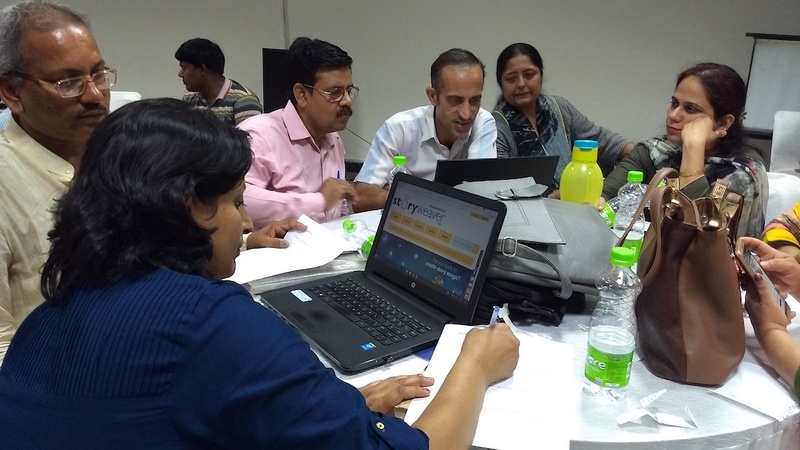
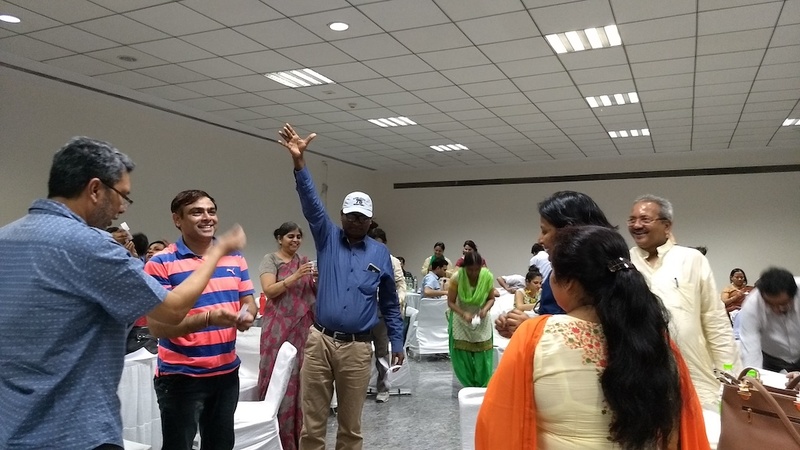
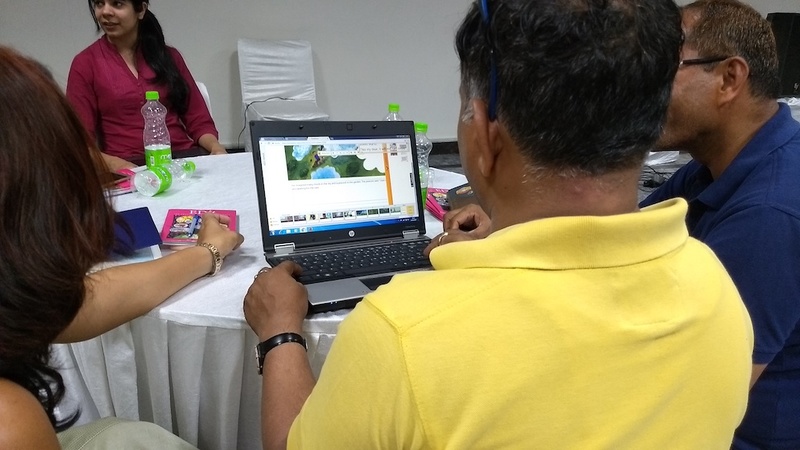
Post lunch, the session was handed over to our expert trainer, Subir Shukla. Subir is a former educational quality advisor to MHRD, Government of India. He developed the quality framework for the implementation of the Right To Education and Sarva Shiksha Abhiyan, India's EFA programme. Subir is now the principal coordinator for Group Ignus, which comprises of IgnusERG (consulting company), Ignus-PAHAL (non-profit) and Ignus-OUTREACH (low cost educational publishing). Subir joined us in training and spent a considerable amount of time with the mentor teachers to take them through some useful ideas on making classrooms more joyful and learning interesting and interactive.
Armed with Subir’s tips and knowledge of StoryWeaver, the participating mentor teachers spent the last part of the day curating content for their subjects and classrooms. Few groups also created some new stories and presented them.
The workshop ended with many enthusiastic mentor- teachers sharing about how they plan to take stories and StoryWeaver to the schools and teachers they work with.
Click here to see more photographs of the day.
We are thankful to all the participating mentor-teachers who attended the training and their resolve to bring back stories into children’s academic lives. We are also grateful to Mr.Shailendra Sharma from Pratham and the Delhi SCERT for giving us this opportunity. A big shout out to Mr.Subir Shukla for the wonderful guidance he extended to all the participants. We will continue to engage with more teachers and Government schools to take many more stories to India’s children.
Be the first to comment.StoryWeaver Spotlight: Aparna Prasanna
Posted by Remya Padmadas on May 09, 2017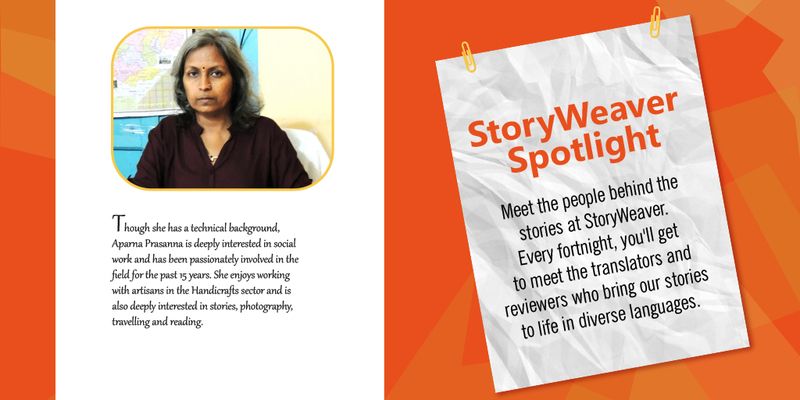
Q: What do you usually read? Which language do you prefer to read
Fiction, non-fiction, history, mythology. I read anything I can lay my hands on. I prefer to read in Kannada and English.
Q: Do you have a favourite book / author and why is it a favourite?
Yes, 'Mankutimmana Kagga' and 'Kaanoorina Heggadati' in Kannada are my favourite books.
Q: You have contributed for us immensely. How has the StoryWeaver journey been?
It has been a wonderful journey, I have enjoyed every bit of it.
Q: Could you share with us a story or anecdote from the translations / reviews? Or one big thing that you take away from this experience?
I have loved experiencing my childhood again with children surrounding me while I read them these stories.
Q: How does it feel when your story gets published online?
Oh! It brings a smile on my face.
Q: You have translated / reviewed a handful of stories for us. Which one has been your favourite and why?
There are two books I am particularly fond of: 'Jadav and the Tree Place' and The Wall Book.'Jadav and the Tree Place' is a very positive story showing how we can create wonders and that efforts do not go wasted. The Wall Book was full of information on human race and its civilisations, which I loved.
Q: What is your key driver in taking this up?
I do feel strongly about my language. And I enjoy translating stories for children so that they can read in their mother tongue.
Q: How else do you think we can join hands in taking bigger steps for children’s literature?
I think introducing story telling sessions, where the kids can narrate stories would be a good step.
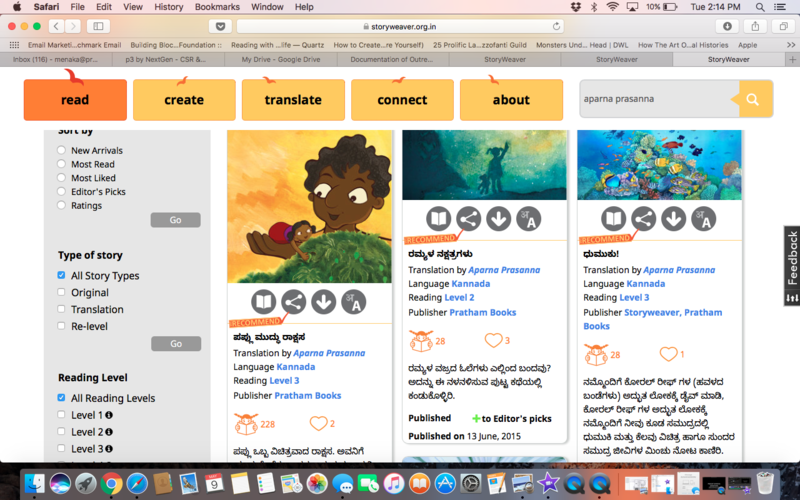
Q: How has the overall experience with StoryWeaver been?
ಅತ್ಯಂತ ತೃಪ್ತಿದಾಯಕವಾಗಿತ್ತು. ಅದ್ಭುತವಾದ ಕಲಿಕಾ ಅನುಭವವಾಗಿತ್ತು
Immensely satisfying and a wonderful learning experience.
Q: You seem to be having fun with the translations and reviews…could you share your 'secret recipe' for this with us?
I just love what am doing!
Be the first to comment.